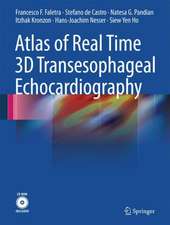Advances in Quantitative Coronary Arteriography: Developments in Cardiovascular Medicine, cartea 137
Editat de Johan H. C. Reiber, P.W. Serruysen Limba Engleză Paperback – 28 oct 2012
Din seria Developments in Cardiovascular Medicine
- 5%
 Preț: 1484.53 lei
Preț: 1484.53 lei - 5%
 Preț: 375.17 lei
Preț: 375.17 lei - 5%
 Preț: 354.10 lei
Preț: 354.10 lei - 5%
 Preț: 1419.03 lei
Preț: 1419.03 lei - 5%
 Preț: 376.43 lei
Preț: 376.43 lei - 5%
 Preț: 1098.27 lei
Preț: 1098.27 lei - 5%
 Preț: 1438.38 lei
Preț: 1438.38 lei - 5%
 Preț: 376.78 lei
Preț: 376.78 lei - 5%
 Preț: 368.37 lei
Preț: 368.37 lei - 5%
 Preț: 380.25 lei
Preț: 380.25 lei - 5%
 Preț: 2117.58 lei
Preț: 2117.58 lei - 5%
 Preț: 367.28 lei
Preț: 367.28 lei - 5%
 Preț: 366.56 lei
Preț: 366.56 lei - 5%
 Preț: 371.10 lei
Preț: 371.10 lei - 5%
 Preț: 370.94 lei
Preț: 370.94 lei - 5%
 Preț: 783.18 lei
Preț: 783.18 lei - 5%
 Preț: 713.18 lei
Preț: 713.18 lei - 5%
 Preț: 1098.27 lei
Preț: 1098.27 lei - 5%
 Preț: 375.49 lei
Preț: 375.49 lei - 5%
 Preț: 373.47 lei
Preț: 373.47 lei - 5%
 Preț: 723.93 lei
Preț: 723.93 lei - 5%
 Preț: 1104.13 lei
Preț: 1104.13 lei - 5%
 Preț: 2117.20 lei
Preț: 2117.20 lei - 5%
 Preț: 716.09 lei
Preț: 716.09 lei - 5%
 Preț: 372.03 lei
Preț: 372.03 lei - 5%
 Preț: 722.33 lei
Preț: 722.33 lei - 5%
 Preț: 660.07 lei
Preț: 660.07 lei - 5%
 Preț: 375.34 lei
Preț: 375.34 lei - 5%
 Preț: 1423.22 lei
Preț: 1423.22 lei - 5%
 Preț: 715.35 lei
Preț: 715.35 lei - 5%
 Preț: 790.69 lei
Preț: 790.69 lei - 5%
 Preț: 720.68 lei
Preț: 720.68 lei - 5%
 Preț: 3185.49 lei
Preț: 3185.49 lei - 5%
 Preț: 1418.27 lei
Preț: 1418.27 lei - 5%
 Preț: 784.64 lei
Preț: 784.64 lei - 5%
 Preț: 714.63 lei
Preț: 714.63 lei - 5%
 Preț: 370.74 lei
Preț: 370.74 lei - 5%
 Preț: 376.22 lei
Preț: 376.22 lei - 5%
 Preț: 660.85 lei
Preț: 660.85 lei - 5%
 Preț: 368.37 lei
Preț: 368.37 lei
Preț: 388.68 lei
Preț vechi: 409.13 lei
-5% Nou
Puncte Express: 583
Preț estimativ în valută:
74.38€ • 77.37$ • 61.41£
74.38€ • 77.37$ • 61.41£
Carte tipărită la comandă
Livrare economică 15-29 aprilie
Preluare comenzi: 021 569.72.76
Specificații
ISBN-13: 9789401048194
ISBN-10: 9401048193
Pagini: 660
Ilustrații: XVI, 640 p.
Dimensiuni: 160 x 240 x 35 mm
Greutate: 0.91 kg
Ediția:Softcover reprint of the original 1st ed. 1993
Editura: SPRINGER NETHERLANDS
Colecția Springer
Seria Developments in Cardiovascular Medicine
Locul publicării:Dordrecht, Netherlands
ISBN-10: 9401048193
Pagini: 660
Ilustrații: XVI, 640 p.
Dimensiuni: 160 x 240 x 35 mm
Greutate: 0.91 kg
Ediția:Softcover reprint of the original 1st ed. 1993
Editura: SPRINGER NETHERLANDS
Colecția Springer
Seria Developments in Cardiovascular Medicine
Locul publicării:Dordrecht, Netherlands
Public țintă
ResearchCuprins
One: Quantitative coronary arteriography (QCA) versus other modalities.- 1. A pathologist’s view of quantitative coronary arteriography.- 2. Angioscopy versus angiography for the detection of coronary artery disease surface morphology.- 3. Development and application of coronary intravascular ultrasound: comparison to quantitative angiography.- Two: QCA: cinefilm versus digital arteriography.- 4. Quantitative analysis of the cineangiogram: Why bother?.- 5. Quantitative coronary arteriography: equipment and technical requirements.- 6. The filmless catheterization laboratory: when will it be reality?.- Three: Quality control in QCA.- 7. Optimal frame selection for QCA.- 8. Variability of QCA-core laboratory assessment of coronary anatomy.- 9. Automated physical assessment of image quality in digital cardiac imaging.- 10. Experiences of a quantitative coronary angiographic core laboratory in restenosis prevention trials.- Four: Coronary blood flow and flow reserve.- 11. Flow and flow reserve by parametric imaging.- 12. Maximal myocardial perfusion as a measure of the functional significance of coronary artery disease.- 13. Angiographic measurement of coronary blood flow.- Five: QCA in regression/progression of atherosclerotic disease.- 14. Value and limitations of quantitative coronary angiography to assess progression or regression of coronary atherosclerosis.- 15. The impact of the calcium antagonist nifedipine on the angiographic progression of coronary artery disease — results of INTACT (International Nifedipine Trial on Anti-atherosclerotic Therapy).- 16. Progression and regression of coronary atherosclerosis: data from a controlled clinical trial with Nicardipine.- 17. Computer quantitative measurements of CLAS coronary angiograms compared to evaluation by panelsof human angiographers.- 18. A maximum confidence strategy for measuring progression and regression of coronary artery disease in clinical trials.- Six: QCA in restenosis studies.- 19. Pharmacological prevention of restenosis after percutaneous transluminal coronary angioplasty (PTCA); overview and methodological considerations.- 20. CARPORT — Coronary Artery Restenosis Prevention On Repeated Thromboxane Antagonism. A multicenter randomized clinical trial.- 21. Angiotensin converting enzyme inhibition in the prevention of restenosis: the MERCATOR and MARCATOR trials.- 22. Historic. A multicenter randomized clinical trial to evaluate feasibility and tolerability of recombinant congener of hirudin as an alternative to heparin during PTCA.- 23. Angiopeptin in experimental models of restenosis.- 24. Cyclic flow alterations and neointimal proliferation following experimental coronary stenosis and endothelial injury.- Seven: QCA after recanalization techniques in coronary arteries.- 25. The use of quantitative coronary angiography (QCA) in interventional cardiology.- 26. Quantitative coronary arteriography in laser balloon angioplasty.- 27. Quantitative coronary angiography after directional coronary atherectomy.- 28. Directional coronary atherectomy evaluation by quantitative angiography.- 29. Quantitative results and lesion morphology in coronary excimer laser angioplasty.- 30. Percutaneous transluminal coronary rotational ablation: early follow-up at 24 hours by quantitative angiography.- 31. Quantitative assessment of the residual stenosis after percutaneous transluminal coronary rotary ablation: European experience.- 32. Quantitative coronary angiography after revascularization with the Transluminal Extraction — Endarterectomy Catheter (TECTM).- Eight: QCA andintracoronary prostheses.- 33. An experimental cardiologist’s view on coronary stents.- 34. The Palmaz-SchatzTM stent.- 35. The Wallstent experience: 1986-1990.- 36 Immediate and long-term clinical and angiographic results following WiktorTM stent implantation in patients with documented restenosis of a native coronary artery lesion following prior balloon angioplasty.- 37. Coronary Gianturco-Roubin Stents.








